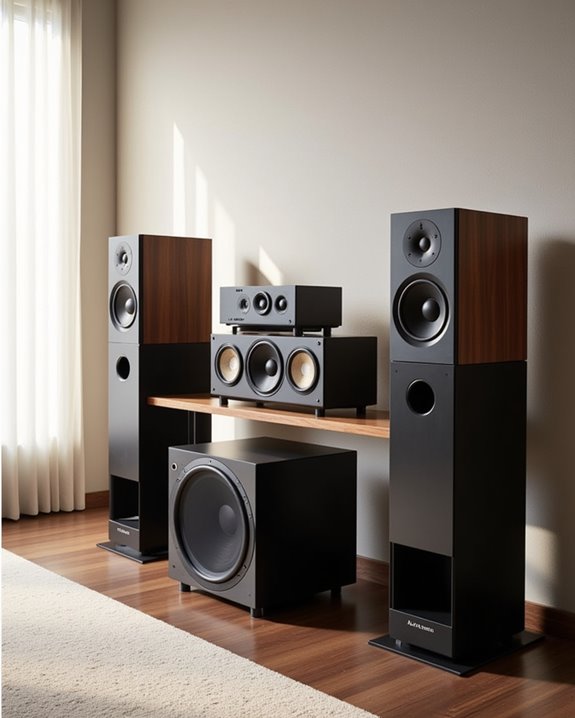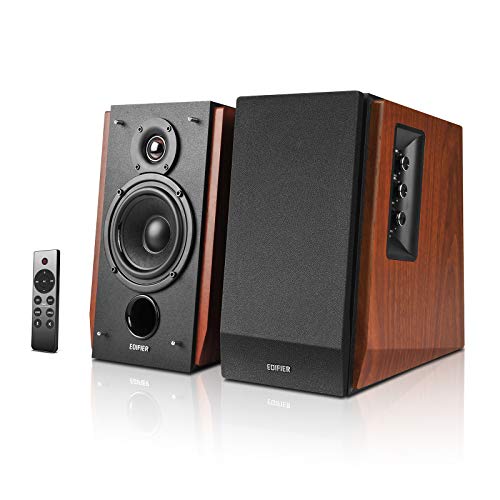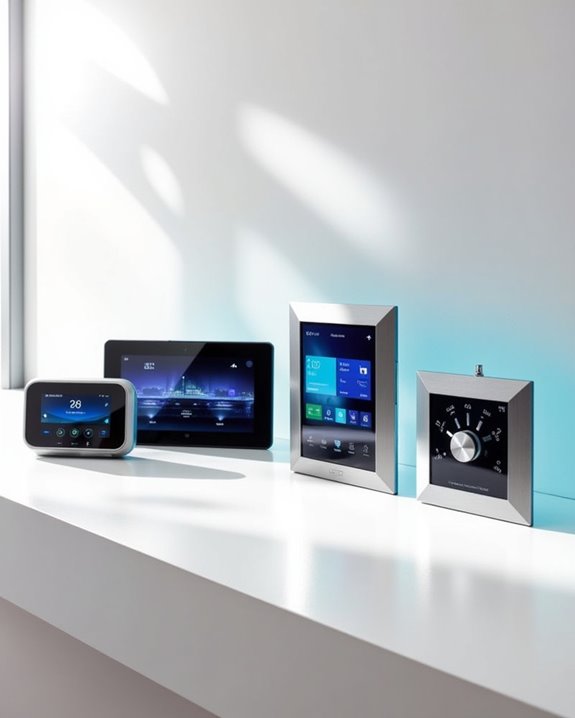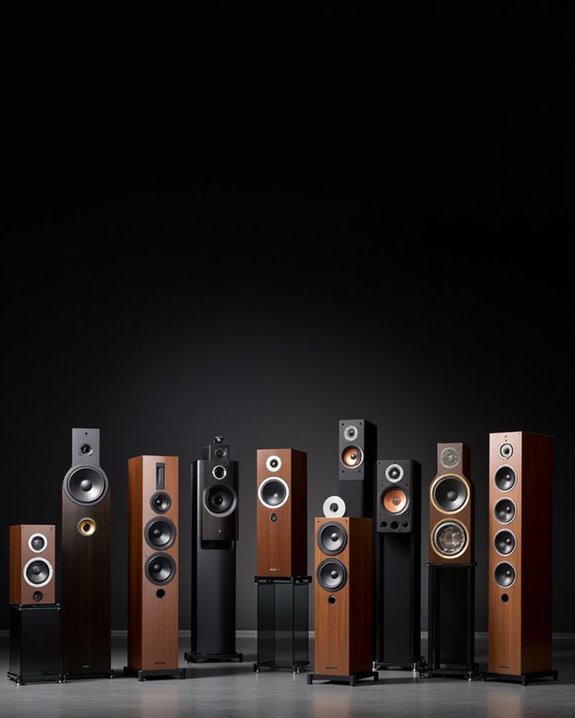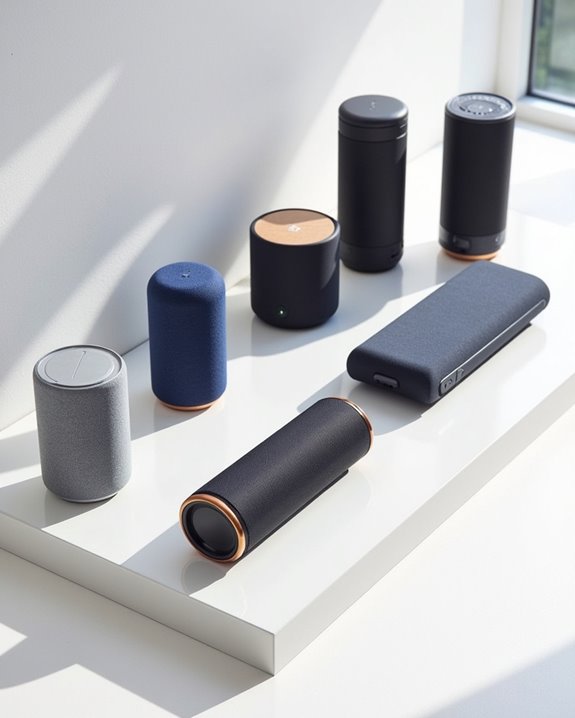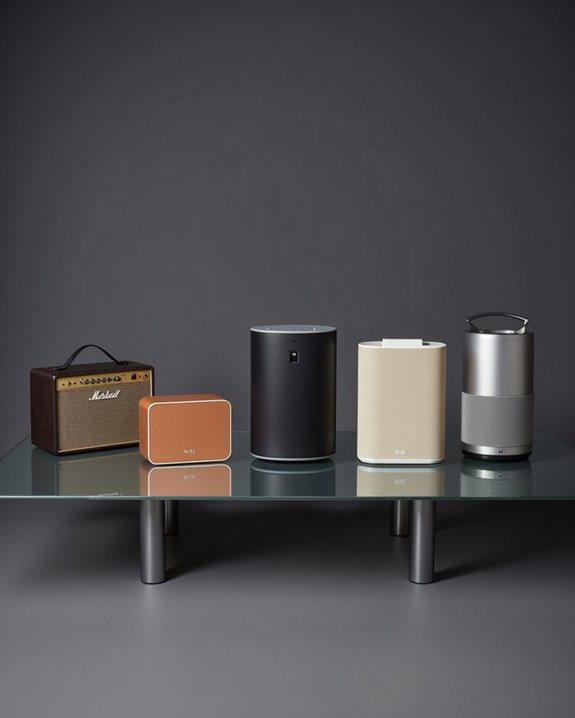For active speakers with subwoofer integration, consider the Edifier R1280DBs with its 42W RMS output and dedicated subwoofer output, or the Edifier R1700BTs delivering 66W through 4-inch woofers with enhanced bass response. The Saiyin speakers offer 40W output with modern Bluetooth 5.3 connectivity, while the Edifier R1280T provides natural sound reproduction with dual RCA inputs. Look for models with proper power matching (40-100W), connectivity options, and room-appropriate specifications. The following comparison explores their technical capabilities in detail.
Key Takeaways
- Edifier R1280DBs offers 42W RMS with 4-inch subwoofer, Bluetooth 5.0, and multiple input options for versatile connectivity.
- Edifier R1700BTs delivers powerful 66W continuous output with 4-inch woofers and includes a dedicated subwoofer output.
- Saiyin speakers provide 40W output with 4-inch woofers, feature Bluetooth 5.3, and include a dedicated subwoofer line-out.
- For spaces over 200 square feet, choose speakers with at least 50 watts RMS to ensure even sound distribution.
- Quality speaker systems should reproduce bass frequencies from 20-30Hz to 200-250Hz with minimal distortion for optimal performance.
Edifier R1280T Powered Bookshelf Speakers
- 2 x AUX INPUT - Convenient connection to any device that has a 3.5mm headphone output or dual RCA output. Play from two devices via AUX at the same time, no plugging and...
- REMOTE CONTROL - Adjust volume at your figure tips. Bass and treble control located on the side of main speaker
- CLASSIC WOOD FINISH - High quality MDF wood build finished with wood effect vinyl serves as a great compliment to any home decor
Audiophiles seeking premium sound quality without breaking the bank will find the Edifier R1280T powered bookshelf speakers an exceptional choice. These 2.0 active monitors deliver 42 watts RMS through a 4-inch woofer and 13mm silk dome tweeter, producing natural sound reproduction with adjustable bass and treble.
You’ll appreciate the premium MDF wooden enclosure, measuring 6.9D x 5.7W x 9.5H inches, which enhances acoustic performance. Connectivity options include dual RCA inputs and an auxiliary port, making them compatible with laptops, gaming consoles, and smartphones. The convenient remote control and side panel adjustments provide easy access to volume and tone settings.
Best For: Budget-conscious audiophiles looking for high-quality bookshelf speakers with natural sound reproduction, adjustable audio settings, and versatile connectivity for various devices including computers, gaming consoles, and music players.
Pros:
- Premium MDF wooden enclosure that enhances acoustic performance while providing an attractive classic design
- Versatile connectivity options with dual RCA inputs and auxiliary port for compatibility with multiple devices
- Convenient control options including side panel adjustments and remote control for volume, bass, and treble settings
Cons:
- Lacks wireless connectivity options such as Bluetooth or Wi-Fi for streaming from mobile devices
- No built-in subwoofer or subwoofer output for those seeking deeper bass response
- At 4.9 kilograms (10.8 pounds), they may be heavier than some alternative bookshelf speakers in the same category
Edifier R1280T Powered Bookshelf Speakers
- 2 x AUX INPUT - Convenient connection to any device that has a 3.5mm headphone output or dual RCA output. Connect to two devices via AUX at the same time, no plugging and...
- STUDIO SOUND QUALITY - Natural sound reproduction from 13mm silk dome tweeter and 4 inch full range unit
- REMOTE CONTROL - Adjust volume at your figure tips. Bass and treble control located on the side of main speaker.
For home audio enthusiasts seeking quality sound reproduction without breaking the bank, the Edifier R1280T powered bookshelf speakers deliver exceptional performance in a classic design. These active near-field monitors output 42 watts RMS through high-quality 4-inch drivers paired with 13mm silk dome tweeters, producing crisp highs and penetrating bass.
You’ll appreciate the versatile connectivity options, including dual AUX inputs that allow simultaneous connection of two devices. The white MDF wood enclosure with vinyl finish offers both aesthetic appeal and acoustic benefits. Control your sound precisely via the included remote or side panel knobs for bass, treble, and volume adjustments.
Best For: Home audio enthusiasts and casual listeners seeking quality bookshelf speakers with impressive sound reproduction at an affordable price point for computer setups, turntables, or small to medium-sized rooms.
Pros:
- Delivers rich audio with crisp highs and punchy bass through its 4-inch drivers and 13mm silk dome tweeters in a compact design
- Features dual AUX inputs allowing simultaneous connection of two devices with convenient remote and side panel controls for audio customization
- High-quality MDF wood construction with attractive white vinyl finish that complements most home decor while providing acoustic benefits
Cons:
- Limited to wired connections only with no Bluetooth or wireless connectivity options
- Not water-resistant, limiting placement options to indoor settings only
- At 4.9 kilograms (10.8 pounds), they’re relatively heavy compared to some competing bookshelf speakers in the same category
Edifier R1280DBs Active Bluetooth Bookshelf Speakers
- BLUETOOTH 5.0 - Pair the speaker with your smartphone, tablet, Mac, or laptop to play music wirelessly, no need to deal with messy wires.
- SUB OUT AND OPT/COAX INPUTS - Subwoofer output with automatic detection and built-in crossover. Optical and coaxial inputs to ensure a lossless connection to TVs and...
- DISTORTION-FREE SOUND - Fill your room with beautiful sound with its 42W continuous undistorted power, 13mm silk dome tweeter unit, and 4-inch sub-woofer unit. Enhance...
The Edifier R1280DBs bookshelf speakers deliver powerful 42W RMS output in a compact, wood-grain finished package that’s ideal for apartment dwellers seeking quality audio without dedicating space to larger systems. These 2.0 active monitors feature a 4-inch subwoofer paired with a 13mm silk dome tweeter, providing crisp highs and tight lows with an impressive 85dB signal-to-noise ratio.
Connectivity options include Bluetooth 5.0, optical, coaxial, and RCA inputs, making them versatile for all your devices. The included wireless remote handles volume, input selection, and power functions, while side panel knobs provide direct bass and treble control. For enhanced bass response, you’ll appreciate the dedicated subwoofer output that auto-detects compatible equipment.
Best For: Home audio enthusiasts, apartment dwellers, or desktop users seeking high-quality sound with multiple connectivity options in a compact, attractive package.
Pros:
- Versatile connectivity with Bluetooth 5.0, optical, coaxial, and RCA inputs accommodates virtually any audio source
- Powerful 42W RMS output with dedicated bass and treble controls provides rich, customizable sound
- Convenient wireless remote control and subwoofer output for easy system expansion
Cons:
- At 10.8 pounds, they’re relatively heavy for bookshelf speakers
- Some users report a subtle delay when using Bluetooth connection
- Plastic material construction (despite wood grain finish) may impact long-term durability
Saiyin Bluetooth Bookshelf Speakers, 40W Powered Speakers for TV and PC
- 𝐏𝐨𝐰𝐞𝐫𝐞𝐝 𝐁𝐥𝐮𝐞𝐭𝐨𝐨𝐭𝐡 5.3 𝐁𝐨𝐨𝐤𝐬𝐡𝐞𝐥𝐟 𝐒𝐩𝐞𝐚𝐤𝐞𝐫𝐬: Pair the bookshelf speakers...
- 𝐀𝐝𝐝 𝐚 𝐒𝐮𝐛𝐰𝐨𝐨𝐟𝐞𝐫 𝐭𝐨 𝐭𝐡𝐞 𝐁𝐨𝐨𝐤𝐬𝐡𝐞𝐥𝐟 𝐒𝐩𝐞𝐚𝐤𝐞𝐫𝐬 :The active bookshelf...
- 𝐌𝐮𝐥𝐭𝐢𝐩𝐥𝐞 𝐖𝐢𝐫𝐞𝐝 𝐈𝐧𝐩𝐮𝐭𝐬:The monitor speakers are built with Optical and coaxial inputs support 24 bit 192k digital...
Perfectly suited for small to medium-sized rooms, these Saiyin Bluetooth Bookshelf Speakers deliver impressive sound quality with their 40W output power and well-balanced acoustic profile. The 4-inch woofers and 0.5-inch silk dome tweeters produce clear highs and punchy bass, handling high volumes without noticeable distortion.
You’ll appreciate the versatile connectivity options, including Bluetooth 5.3, optical, coaxial, and AUX inputs that support 24-bit/192kHz digital audio. The dedicated subwoofer line-out allows for system expansion, while the included remote control provides convenient access to sound adjustments. With dimensions of 150x170x240mm and solid wood construction, these speakers blend aesthetic appeal with acoustic performance, earning a respectable 4.4/5 stars from over 1,500 users.
Best For: Users seeking high-quality bookshelf speakers with multiple connectivity options for small to medium-sized rooms, home theaters, or desktop setups who want excellent sound without requiring an external amplifier.
Pros:
- Versatile connectivity with Bluetooth 5.3, optical, coaxial, and AUX inputs supporting high-resolution 24-bit/192kHz audio
- Powerful 40W output with 4-inch woofers that deliver punchy bass and clear sound even at high volumes
- Expandable audio system with dedicated subwoofer line-out for those wanting enhanced bass performance
Cons:
- Some users report occasional Bluetooth dropouts that may affect wireless streaming reliability
- Bright indicator lights might be distracting in darkened room environments
- Limited treble performance compared to higher-end bookshelf speakers as noted in customer feedback
Edifier R1700BTs Active Bluetooth Bookshelf Speakers
- BLUETOOTH 5.0 WITH QUALCOMM APTX HD - Easily connect to your phone, laptop or tablet for wireless listening enjoyment, suitable for iOS, Android, Mac, or Windows devices....
- SUB OUT - Subwoofer output with built-in crossover and auto detection. Dual RCA inputs for phone, TV, DVD, PC connection, support connect to two devices at the same time,...
- NATURAL SOUND REPRODUCTION - Get the cleanest and most impressive natural sound from the 19mm silk dome tweeter unit, 4 inches woofer unit, and 66W continuous undistorted...
Audiophiles seeking premium sound quality without breaking the bank will find the Edifier R1700BTs speakers an impressive solution for their listening needs. These active bookshelf speakers deliver 66W of continuous power through their 4-inch woofers and 19mm silk dome tweeters, creating rich bass and crisp highs with natural sound reproduction.
Connectivity options include dual RCA inputs, Bluetooth 5.0 with Qualcomm aptX HD support for 24-bit audio quality, and a dedicated subwoofer output with auto-detection. You’ll appreciate the convenient side panel EQ controls and updated wireless remote for volume adjustment and mode switching. At 6.6kg with dimensions of 6.06″D×8.43″W×10″H, these wood-constructed speakers maintain a 4.6/5 star rating across 2,134 customer reviews.
Best For: Audiophiles and music enthusiasts seeking high-quality sound reproduction in a compact, versatile speaker system that offers both wired and wireless connectivity options at a reasonable price point.
Pros:
- Impressive sound quality with 66W continuous power, 4-inch woofers and silk dome tweeters delivering rich bass and crisp highs
- Versatile connectivity including Bluetooth 5.0 with aptX HD support, dual RCA inputs, and a dedicated subwoofer output
- Convenient control options through both the side panel EQ adjustments and the included wireless remote control
Cons:
- Grill durability issues reported by some users in reviews
- Button visibility could be improved for easier operation
- At 6.6kg (14.5 pounds), they’re relatively heavy for bookshelf speakers of this size
Factors to Consider When Choosing Active Speakers and Subwoofer
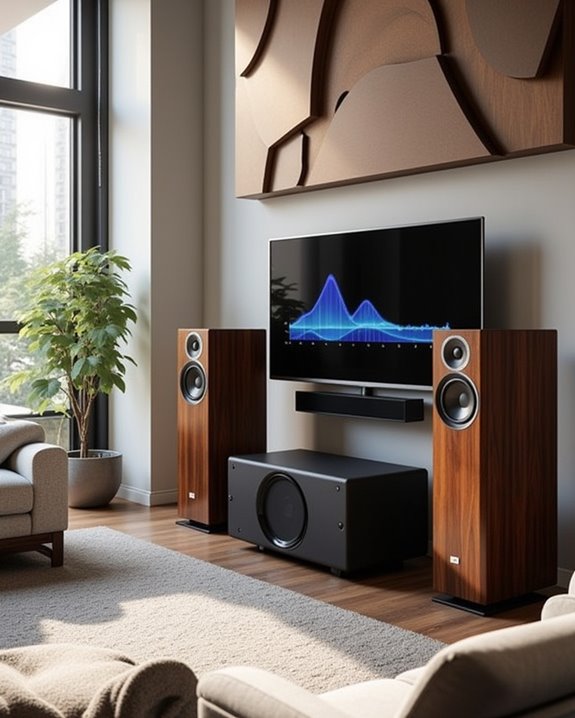
When selecting active speakers and a subwoofer system, you’ll need to evaluate several critical factors that directly impact audio performance. Consider the power output requirements, which determine volume capabilities and dynamic range, alongside connectivity options that guarantee compatibility with your existing audio equipment. Your room size, build material quality, and bass response range will further influence sound propagation, durability, and low-frequency reproduction—all essential elements for achieving ideal audio fidelity.
Power Output Requirements
How much power do you truly need from your active speakers and subwoofer? Understanding RMS wattage—the continuous power handling capacity—is essential for selecting equipment that matches your listening environment.
For active speakers, aim for 40-100 watts per channel in larger rooms to maintain distortion-free sound at higher volumes. Your speakers’ sensitivity rating (measured in dB per watt) greatly impacts performance; models with 85-90 dB sensitivity require less power to achieve comparable volume levels.
Subwoofers demand substantially more power—typically 50-200 watts RMS—to reproduce low frequencies below 100 Hz accurately. This higher power requirement guarantees tight, controlled bass without distortion during demanding passages.
For home theater applications, select systems delivering at least 60 watts RMS to handle dynamic audio peaks effectively. Remember, proper power matching between your space and equipment prevents clipping and guarantees ideal audio quality throughout your listening experience.
Connectivity Options
The versatility of modern active speakers and subwoofers hinges vitally on their connectivity options, which determine compatibility with your existing audio ecosystem. Wireless Bluetooth connectivity offers convenient pairing with your devices within a 10-meter range, while wired inputs like RCA and optical cables deliver superior stability with signal-to-noise ratios around 85 dB.
You’ll benefit from systems featuring multiple input types—auxiliary, coaxial, and digital—allowing simultaneous connection of various audio sources. For ideal bass integration, look for dedicated subwoofer outputs with automatic detection capabilities, enhancing your 2.0 or 2.1 configuration. Many premium models include remote controls that facilitate seamless switching between connectivity modes without manual adjustments. When evaluating speakers, prioritize those offering both wireless convenience and high-fidelity wired options to future-proof your investment.
Room Size Considerations
Selecting active speakers and subwoofers perfectly matched to your room’s dimensions represents a critical factor that many audio enthusiasts overlook. For spaces exceeding 200 square feet, you’ll need speakers delivering at least 50 watts RMS to achieve even sound distribution throughout the larger area. Conversely, rooms under 150 square feet perform well with 20-40 watt speakers, providing adequate volume without overwhelming the acoustic environment.
Your room’s shape greatly impacts bass performance, particularly in larger spaces where subwoofers must efficiently reproduce frequencies below 80 Hz. When positioning speakers in larger rooms, maintain 6-8 feet of clearance from walls to minimize bass buildup and enhance clarity. High ceilings or irregular layouts require additional power adjustments based on total cubic footage rather than just floor area.
Build Material Quality
Beyond room sizing, construction materials serve as the foundation of acoustic performance in any speaker system. When evaluating active speakers and subwoofers, you’ll want to examine the density and composition of their enclosures carefully.
High-density woods and composite materials offer superior vibration absorption, reducing unwanted resonance that can color your audio. These denser materials typically yield signal-to-noise ratios up to 85 dB, ensuring cleaner sound reproduction. Look for cabinets with natural damping properties that minimize distortion, particularly in the vital mid-range frequencies.
Weight distribution matters greatly during high-volume playback, as heavier, well-constructed units maintain stability without unwanted movement. Additionally, consider how surface finishes impact both internal airflow and heat dissipation, critical factors that extend component lifespan and maintain performance integrity during extended listening sessions.
Bass Response Range
When evaluating the bass response range of active speakers and subwoofers, you’ll need to understand how low frequencies fundamentally shape your listening experience. A quality system should reproduce frequencies from as low as 20-30Hz up to 200-250Hz with minimal distortion, providing the foundation for immersive audio.
Look for specifications that indicate a flat frequency response curve across this range, as this guarantees balanced bass reproduction without artificial peaks. Driver size directly impacts low-frequency capability, with larger drivers typically handling deeper bass down to 30Hz or below. For movie enthusiasts, prioritize systems that reach below 40Hz to capture those theater-like rumbles in action sequences.
The enclosure design also greatly affects bass extension, with ported designs often delivering deeper bass response compared to sealed cabinets of the same size.
Design Aesthetics
While superior bass response delivers the foundation of your audio experience, the visual presence of your speakers will shape how they integrate into your living space. Consider enclosure materials carefully, as premium MDF or hardwood options provide both acoustic benefits and refined aesthetics compared to basic plastic variants.
Your finish selection greatly impacts room integration—matte surfaces minimize distracting reflections, while high-gloss finishes create elegant focal points. Size constraints matter; compact 6-8″ designs offer placement flexibility, whereas larger 10-12″ enclosures command more presence.
Color selection should complement your existing décor, with neutral tones (black, white, walnut) offering the most versatile integration. Pay attention to grille design and control panel placement—symmetrical, minimalist designs typically age better than busy interfaces. Front-facing controls improve accessibility while maintaining clean side profiles.
Crossover Frequency Settings
The crossover frequency represents a critical junction in your audio system’s signal path, determining exactly where bass frequencies transfer from your main speakers to your subwoofer. For ideal performance, you’ll typically want to set this between 80-120Hz, ensuring each component operates within its ideal range.
Your speaker size greatly influences this setting. Smaller bookshelf models may require crossovers above 100Hz to prevent distortion, while larger floor-standing speakers can handle lower crossover points. This prevents frequency overlap that might cause muddy or boomy bass reproduction.
Don’t hesitate to experiment with 10-20Hz adjustments to find your system’s sweet spot. Room acoustics play a substantial role in determining the ideal crossover frequency, and even small changes can dramatically improve coherence between your subwoofer and main speakers, creating a seamless, balanced soundstage throughout your listening environment.
Budget Vs Performance
Balancing your budget against desired performance represents the fundamental challenge when selecting active speakers and a subwoofer for your audio system. Higher investments typically yield tangible improvements in key specifications:
- Power output: $300+ models offer 40W+ RMS ratings, delivering distortion-free audio at higher volumes
- Signal-to-noise ratio: Entry-level units (85dB) introduce more background noise than premium options (90dB+)
- Bass response: Budget-friendly subwoofers rarely reach below 50Hz, while premium models extend deeper for richer low frequencies
- Connectivity: Higher-priced systems often include Bluetooth 5.0 with 10-meter range versus basic wired connections
When evaluating your needs, consider that sub-$300 speakers prioritize fundamental metrics, while premium options include adjustable EQ controls for bass and treble customization. The performance gap becomes particularly noticeable in larger rooms where power and clarity requirements increase.
Frequently Asked Questions
Can Active Speakers Work Without Being Plugged Into Power?
No, active speakers cannot work without being plugged into power. Unlike passive speakers that rely on external amplifiers, active speakers have built-in amplification that requires electricity to function. You’ll always need to connect them to a power outlet to drive the internal amplifier that processes and boosts audio signals. Without power, the integrated amplifier cannot operate, rendering the speakers completely silent regardless of the audio input source.
How Do I Connect Multiple Audio Sources to Active Speakers?
You can connect multiple audio sources to active speakers in several ways. Use an audio interface or mixer with multiple inputs, connecting each source to separate channels. Alternatively, employ a stereo switch box that allows toggling between sources. Some active speakers feature multiple input options (RCA, XLR, 3.5mm, optical) that you can use simultaneously. For wireless options, consider Bluetooth-enabled speakers that pair with multiple devices or speakers with built-in source selection functionality.
Do I Need an Amplifier With Active Speakers?
No, you don’t need an amplifier with active speakers. Active speakers, sleek and self-sufficient, already contain built-in amplification circuitry. The integrated amplifiers are precisely matched to the speaker drivers, ensuring ideal power distribution and sound reproduction. This all-in-one design eliminates the need for external amplification, reduces cable clutter, and simplifies your audio setup. You’ll only need to connect your audio sources directly to the speakers’ inputs, which typically include RCA, XLR, or digital connectivity options.
What’s the Difference Between Active Speakers and Passive Speakers?
Active speakers have built-in amplifiers, meaning you don’t need an external amp to power them. You’ll simply connect your audio source directly to the speakers. Passive speakers, however, require an external amplifier to function, as they don’t have internal power amplification. Active speakers offer convenience and simplified setup, while passive speakers provide more flexibility for upgrading individual components of your system. Most commercial home speakers are passive, while many studio monitors are active.
How Far Can Bluetooth Speakers Maintain Stable Connection With Devices?
Bluetooth speakers typically maintain stable connections within 30-100 feet (10-30 meters), depending on the device’s Bluetooth version and environmental factors. Most modern speakers using Bluetooth 5.0+ can reach the upper range in open spaces, while walls, interference, and obstacles reduce this considerably. You’ll experience ideal performance within 15-30 feet, with connection quality degrading as you approach maximum range. Higher-end models often incorporate signal boosters to extend reliable transmission distances.

